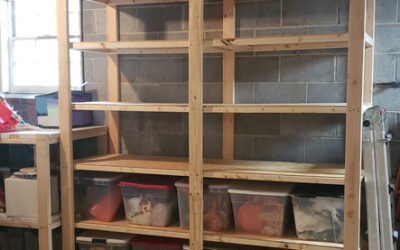So, you’ve invested in some quality camping gear, huh? Nice! But let’s get real: What’s the best way to store camping gear? A drenched tent or moldy sleeping bag is nobody’s idea of fun on a camping trip. And rummaging for that one utensil? Maddening!
Camping storage ideas don’t just revolve around tidiness. How we stash our stuff can directly affect our next outdoor experience. We’re going to chat about this and much more, from battery-powered gadgets to those trusty boots. And by the end, you’ll be a pro at gearing up – or in this case, gearing down – for your adventures.
Gear Cleaning and Maintenance
Ever had that moment where you unrolled your tent, only to find it still dirty from your last trip? Or did you zip up your sleeping bag and get stuck halfway because the zipper decided it needed a day off? A touch of TLC after every trip is all it takes to wave goodbye to these unpleasantries.
- Shake out any debris from your tent, give it a gentle wash with mild soap and allow it to air dry completely before folding and putting away.
- Spot cleaning or a gentle hand wash works best for sleeping bags. Although it’s tempting to smoosh them to save space, it is best that you store them uncompressed if you want them to have a long, happy life.
- Inspect your camping gear after use and before storing it away. Regular checks for tears, broken parts or other signs of wear can prevent bigger issues down the line.
- Want to avoid zipper issues? A dab of zipper lubricant keeps them running smoothly and prevents those frustrating “stuck zipper” moments.
Sort and Organize Your Camping Gear
Searching for camping gear in an unorganized pile feels a lot like trying to find a needle in a haystack. Taking the time to first organize your gear can make things easier not only to store but also to find items later. These tips should be your starting point:
- First, organize your gear into main categories: shelter, sleep supplies, lighting, food and storage.
- Depending on the season, your gear list might change. Having separate checklists for summer and winter ensures you are always prepared. Beach towel or thermal blanket? Not quite the same, but your list will guide you.
- In your checklist, make a distinction between permanent and single-use items. This way, you will know what needs a refill or wash after each trip. And if there’s an item you’ve used up or needs repair? Don’t stash it away. Leave it out as a reminder to replenish or fix.
- Clearly label your containers. Whether it’s ‘Cooking Supplies’ or ‘Sleeping Gear’, a well-labeled bin saves you time. A laminated list taped to the inside of each lid is also a great idea for checking items off when packing.
Oh, and here’s an idea: Why not turn this whole sorting and organizing process into a fun family activity? Yup, get the kids involved and have them sort camping toys and books.
Suitable Containers for Storing Camping Gear
You know, it’s one thing to have all your camping gear ready, but where do you put it all? Camping storage solutions often boil down to the right container as it can make a world of difference.
- Clear bins are a peek-a-boo treat! At a glance, you can see what’s inside. But, if your gear is often exposed to sunlight, go opaque.
- Go for durable, waterproof plastic totes and think modular. They’re great for stacking and quite a space-saver. Many seasoned campers like Amelia Mayer and the team at Tales of a Mountain Mama swear by the black bins at Costco for this very reason.
- Smaller containers for individual items make better use of space, especially in tight spots.
- Choose containers with sealable lids to keep your gear safe from unwanted moisture and critters.
Mayer also offers a genius hack for those short on storage space. “Prop beds up on higher frames to store gear underneath them,” she said. It’s a clear way to maximize space and have a secret gear stash below the bed. A cheap and simple solution is to just put some wood blocks under the bed posts. This may very well be the best way to store camping gear in a small apartment, come to think of it.
Climate-Controlled vs. Non-Climate-Controlled Storage
Nobody wants to open their camping gear for the season and get greeted by a musty smell or, worse, mold. That’s the nasty side effect of humidity and temperature playing tricks on your stuff. But don’t fret; there’s a way around it — climate control.
Climate-Controlled Solution for Small Apartments
Do you count yourself among the folks with snug living spaces? Maybe you should opt for an external storage unit. And if you can swing it, the climate-controlled ones provide steady temperatures and low humidity all year round for your gear.
Climate-Controlled Solution on a Budget
If climate-controlled storage units sound a tad too posh for your gear, there are other camping storage ideas and tricks to try. How about moisture absorbers? Whether it’s a non-climate-controlled storage unit that you’ve got your hands on or some extra space in the basement or attic, here are four DIY options:
- Silica gel. Those little packets you often find in shoe boxes and electronics packaging contain small beads of silica that absorb moisture well.
- Calcium chloride. Often found in hanging bags or tub containers, this substance effectively absorbs excess moisture from the air. You might see these sold as DampRid or similar products, commonly used for basements, closets or bathrooms.
- Activated charcoal. Besides absorbing odors, it also absorbs moisture. It’s common in products designed for home use, especially for spaces like closets and cars.
- Baking soda. While not as effective as some commercial products, it can absorb some moisture and is sometimes used in fridges to control odors and humidity.
Of course, moisture is only half of the problem. The other half is temperature fluctuations and extremes. If there is no cool place available during summer, or if winters are particularly harsh, circle back to renting a climate-controlled unit for your camping gear.
Pack and Protect Smaller Items
Have you ever struggled with misplaced kitchen utensils, wet electronics or mildewed items in your camping stash? It’s a common frustration, but there are simple camping storage solutions to keep everything safe and sound.
- Dry bags are life jackets for your electronics. A rainy day won’t ruin your gadgets if they’re snug in here.
- Ziplock bags are not just for sandwiches. Slide in your maps, important docs or even that wet washcloth.
- Got Tic Tac boxes? Empty them out and fill them with spices or safety pins. Perfect for those “I knew I packed it somewhere!” moments.
- Pill organizers aren’t just for grandma. Use them for spices, tiny essentials or, well, pills.
- Mesh bags are great for dishes as they dry stuff out, and compartmentalized organizers keep your cutlery from playing hide-and-seek.
- Dealing with cord chaos? Bundle them up with rubber bands and twist ties and enjoy the satisfaction of neatness.
Storing Camping Clothing and Footwear
Camping might mean braving the elements, but your clothes shouldn’t continue the battle in storage. Make sure they’re bone dry before tucking them away. Following these insider tips now can keep your clothing and footwear in good shape season after season:
- Shoe trees aren’t just for fancy leather shoes. Pop them in your boots to keep them looking sharp and ready for the next adventure.
- After a long hike, your shoes need a breather. Aerate them well and for a little added touch, tuck in some moisture-wicking packets.
- How about a special basket just for clean hiking and camping clothes? When you’re back from a trip, wash, fold and drop them here. No more searching high and low for that favorite hiking tee!
Tent and Sleeping Gear Storage
Unpacking after a trip can be just as important as packing before one. Especially when it comes to the delicate balance of tent and sleep gear.
- No matter how eager you are to pack away that tent, resist the urge if it’s damp. Air it out fully to ward off any mold or mildew.
- As Mayer told us, sleeping bags need a bit of extra care. “Down items and sleeping bags shouldn’t be compressed because long-term compression can crimp the inside particles,” she said. “Let them hang or pack them in larger-than-necessary mesh sacks so they’re well ventilated and more apt to return to full size when you’re ready to use again.” If you have the space, designate a spot in your basement or storage room to hang them.
- Treat poles and stakes like the backbone of your tent because they are. Store poles in their carry case and always give them a once-over for any wear or tear. Or do as the team at Tales of a Mountain Mama did. “We added brackets to our basement ceiling to store our tent poles stretched out.”
- Had a sandy getaway? Ensure you brush off all those beach memories before storing your tent. And if you’re in a pinch, plastic totes without lids can be a good compromise between easy access and protection.
Cooking and Food Equipment
Food on a camping trip can be such a treat! But let’s be real: the aftermath? Not always the most fun. From leftover s’mores bits to grimy stoves, here’s how to keep your cooking gear clean and tidy until the next trip.
- Clean off any food residue from the stove and cookware. Before storing camping gear like this, make sure your gas canisters are empty and detached.
- Airtight containers are your best pals for storing food or even cooking essentials like salt and spices. They keep things fresh and are great at preventing critter visits.
- If you’ve ever been surprised by a mouse’s midnight snack in your gear, you know the importance of this. Stow away your food containers in a bin with a real tight-sealing lid. Those little rascals won’t stand a chance.
- Consider having a separate set of kitchen supplies exclusively for camping. Why? It makes packing a breeze. Everything you need is already together, and there’s no “Did I remember the spatula?” moment as you head out.
Battery-Operated Gear
Before storing battery-operated camping gear, always take out the batteries and store them safely. This isn’t just for things like flashlights and radios, but also for camping lanterns, portable fans and electronic insect repellents.
- All of your battery-operated buddies prefer the shade. A cool, dry place away from direct sunlight is perfect for your electronics.
- If you’re really into keeping things in tip-top shape, grab a battery tester. It’s an easy way to know which batteries are ready for action and which ones have retired.
Secure Your Camping Gear
Ever had that sinking feeling when you can’t find your beloved camping gear? Or worse, realizing it’s not misplaced, but missing? Your storage area should be a fort. Double up on those locks or even consider adding a security system. Your camping gear is an investment, after all. Motion-sensitive lights can also deter sneaky visitors and make late-night gear-grabbing a breeze.
Now, with all that camping gear, it’s easy to lose track but there are apps that can help you keep tabs on what you have and in what condition. Gear Inventory, GearLog or Carryless are great opinions for keeping track of what you have. This way, you’ll know if any piece of gear goes missing — a useful tool when multiple people have access to your storage area, as is often the case.
Regular Checkups and Maintenance
Picture this: you’re all set for the great outdoors, and just as you’re about to strike up your stove, it gives out. Or even worse, you reach into your first-aid kit and find it’s missing that crucial band-aid. Avoid these ‘oh-no’ moments with regular checkups and maintenance.
- Sync up your calendar with camping seasons and perform seasonal inspections. Schedule gear checks before you pack and after you unpack. It’s your best shot at catching any sneaky wear and tear. While you’re at it, note down anything that’s looking a little worse for wear. A stitch in time and all that, right?
- Essentials have a sneaky way of running out when you least expect it. Always keep your first-aid kits and other must-have items fully stocked.
And now, something that the team at Tales of a Mountain Mama swears by: “Lists, lists, lists! We have a packing list on our site that people can download for free and use. Plus, you can adjust and modify it as you need.” They also suggest keeping a running list on your phone of things you need to add to your camping gear. “You’re more likely to remember these things when you’re out camping than when you’re gearing up for the next trip,” they added.
How To Pack for Future Adventures
Is excitement brewing for that next big camp outing? Great! But before you get lost in dreams of starry nights, there are a few things to go over before the actual packing:
- Store the MVPs (Most Valuable Pieces) of your camping gear at the front or top of your storage area or backpack. No more frantic rummaging for that trusty flashlight.
- How about a ready bag with all your camping essentials for those impromptu adventures? Just grab it and hit the road!
- Mayer’s got a tip that’s pure gold for tent camping. “Pack the truck in order. First things toward the tailgate and last things up front. Especially if it’s raining, you only need to grab what’s essential to set up,” she emphasized.
- Pack smart, not more. Remember, every extra shirt or fragrant lotion might just be extra weight. Focus on multi-use gear and avoid the pitfall of overpacking.
- Consider color-coding items or bags. It’s not just pretty; it’s practical. Different colors can mean faster packing and unpacking.
And another golden nugget from Mayer to mull over: Don’t buy gear you don’t need (yet). “Most beginner outdoor activities don’t require a lot of specialized gear, as your activities get more advanced, you can always add the appropriate gear,” she advised.
Now You Know How To Store Camping Gear
Let’s recap the best ways to store camping gear. First, it’s important to keep that tent dry and give sleeping bags room to breathe. We touched on how to protect smaller gadgets and keep clothes and boots in good shape. Also remember that a tidy storage spot and regular gear checkups go a long way. Finally, as you plan your next outing, organizing and being mindful of what you pack can set you up for more outdoor fun!


